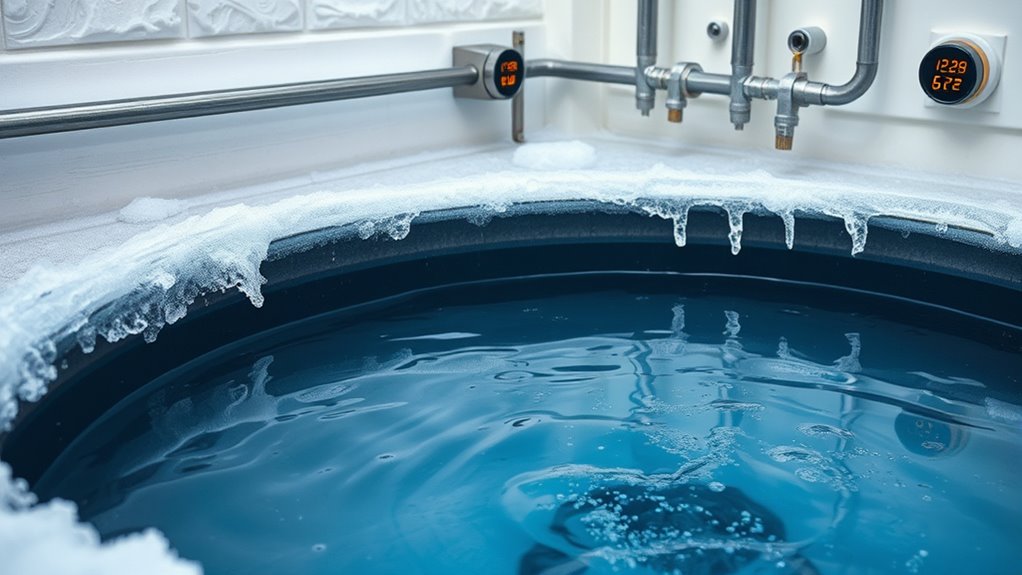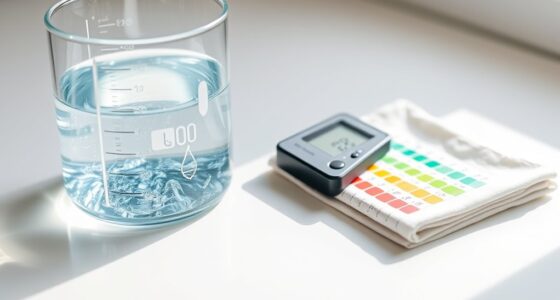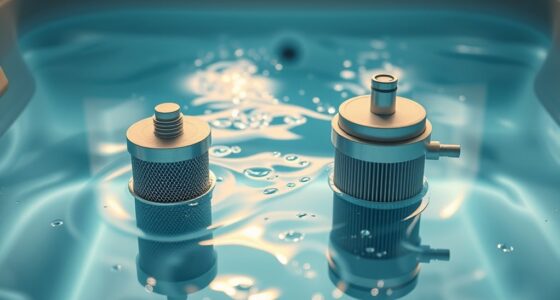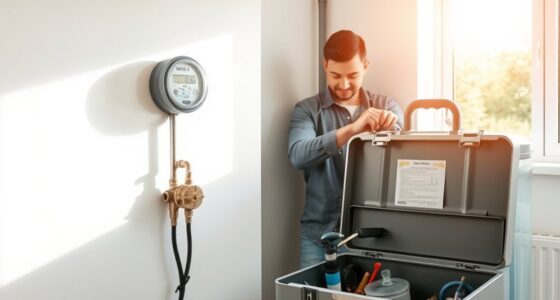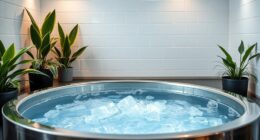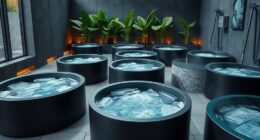To manage temperature fluctuations in your cold plunge, regularly monitor water temperature with a calibrated thermometer and adjust as needed with ice or cooling systems. Guarantee your circulation pumps and filters work properly to promote even water distribution and prevent hot or cold spots. Keep external influences like sunlight in check by using covers or shades. Maintaining equipment and controlling environmental factors help keep the water stable, so you’ll discover more ways to optimize your plunge experience.
Key Takeaways
- Regularly calibrate thermometers to ensure accurate temperature readings for effective monitoring.
- Maintain water circulation with pumps and filters to promote even temperature distribution.
- Use covers or shades to shield the pool from sunlight and external heat sources.
- Monitor environmental conditions and adjust water with ice or cooling methods as needed.
- Perform routine equipment maintenance and inspections to prevent malfunction-induced temperature fluctuations.
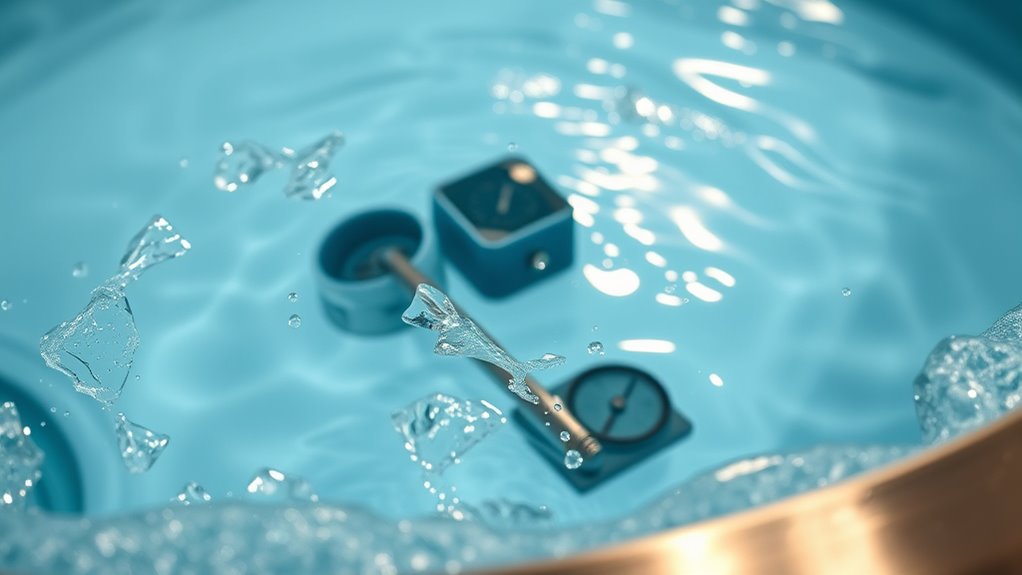
Maintaining a consistent temperature in your cold plunge water is essential for maximizing its health benefits and ensuring a safe experience. When water temperature fluctuates, it not only diminishes the therapeutic effects but can also pose safety risks. To keep things steady, you need to pay close attention to your thermometer calibration. A properly calibrated thermometer provides accurate readings, so you know exactly when your water reaches your desired temperature. Regularly check and calibrate your thermometer according to the manufacturer’s instructions, especially after long periods of use or if you notice inconsistent readings. Accurate temperature readings enable you to make timely adjustments and prevent unintended temperature shifts.
In addition to accurate thermometers, your water circulation systems play a pivotal role in managing temperature fluctuations. These systems, which include pumps and filters, help distribute the cold water evenly throughout the plunge. When water circulates efficiently, it prevents cold or warm spots from forming, maintaining a uniform temperature throughout the entire basin. Proper circulation also aids in the rapid dissipation of any heat introduced by external factors, such as ambient temperature changes. If your circulation system isn’t functioning *excellently*, you might notice temperature inconsistencies, which can be uncomfortable or unsafe. Regularly inspect and maintain your water circulation systems to ensure they operate smoothly. Clean filters, check for leaks, and verify that pumps are working at full capacity.
Another way to manage fluctuations is by monitoring the environment around your cold plunge. External heat sources, like sunlight or nearby heating elements, can cause the water temperature to rise unexpectedly. Installing a cover or shade can help mitigate these effects, keeping the water at a steady, cold temperature. Additionally, consider setting a schedule for water testing and adjustments. For example, check the water temperature at regular intervals, especially during hot days or after heavy use. If you notice the temperature drifting from your target range, make small, immediate adjustments to your cooling system or add ice as needed.
Furthermore, understanding the role of contrast ratio in your setup can help you better gauge how temperature fluctuations impact your overall experience, especially in relation to image and environment quality. Ultimately, controlling temperature fluctuations requires a combination of proper equipment maintenance, vigilant monitoring, and environmental management. Regularly calibrate your thermometer to guarantee accurate readings, and ensure your water circulation systems are working *efficiently*. By doing so, you create a stable environment that maximizes the health benefits of your cold plunge, keeps your experience safe, and prolongs the life of your equipment. Staying proactive in managing these factors helps you enjoy consistent, therapeutic cold water immersion with confidence.
Frequently Asked Questions
How Does Ambient Temperature Affect Cold Plunge Water Stability?
Ambient heat considerably impacts cold plunge water stability by causing water temperature to rise, making water cooling necessary to maintain desired cold levels. When ambient temperatures are high, the water absorbs heat more quickly, requiring you to monitor and adjust cooling methods regularly. Conversely, cooler ambient conditions help keep the water stable longer, reducing the need for frequent cooling and ensuring a consistent cold plunge experience.
Can Adding Chemicals Help Maintain Consistent Water Temperature?
Adding chemicals like chemical additives or temperature stabilizers doesn’t actually help maintain consistent water temperature. These substances mainly control water quality, prevent algae, and reduce bacteria. To keep your cold plunge water stable, focus on proper insulation and a reliable heating or cooling system. Chemicals can’t substitute for good equipment; instead, they support water clarity and safety, not temperature regulation.
What Are the Signs of Temperature Fluctuations Damaging Equipment?
You’ll notice equipment durability issues like cracks, leaks, or malfunctioning temperature sensors when temperature fluctuations occur. These signs indicate that inconsistent temperatures strain your system, causing wear and tear. You might also see erratic temperature readings or equipment shutting down unexpectedly. Monitoring your temperature sensors closely helps detect early damage, ensuring you can address issues before they lead to costly repairs or equipment failure.
How Often Should I Test Water Temperature for Consistency?
Think of your cold plunge water like a delicate dance; you want to keep it steady. You should test water temperature at least twice daily, morning and evening, to guarantee consistency. Regularly check your thermometer’s accuracy and consider water heater calibration to avoid surprises. This way, you maintain safe, ideal temperatures, preventing equipment strain and ensuring a comfortable experience. Consistent testing keeps your plunge running smoothly.
Are There Specific Insulation Materials Best for Temperature Regulation?
You should select insulation types like foam board, spray foam, or fiberglass for effective thermal barriers. These materials decrease heat exchange and maintain consistent water temperature. Spray foam offers excellent sealing, while rigid foam board is easy to install. Avoid materials that absorb moisture or degrade over time. Proper insulation guarantees your cold plunge stays at the desired temperature longer, making your experience more comfortable and energy-efficient.
Conclusion
By mastering methods to monitor and maintain the melt of temperature, you guarantee your cold plunge stays consistent and comfortable. Regular checks, swift adjustments, and strategic insulation keep fluctuations at bay. With diligent dedication, you’ll delight in a durable, dependable dip that delivers chilled chills without chaos. Embrace these effective practices, and your cold plunge becomes a calming, controlled, and consistent sanctuary, supporting your wellness journey with unwavering unwavering water warmth.
